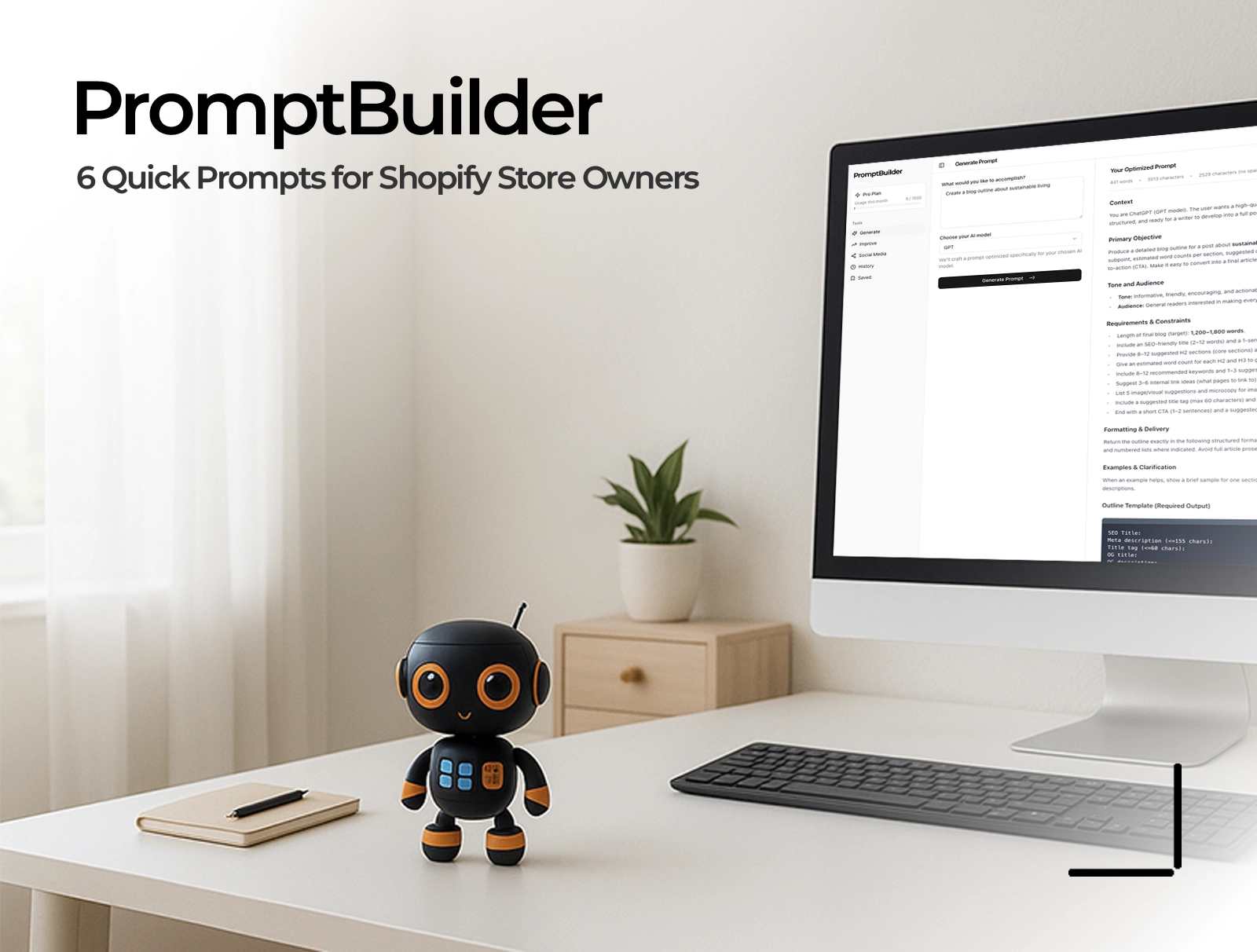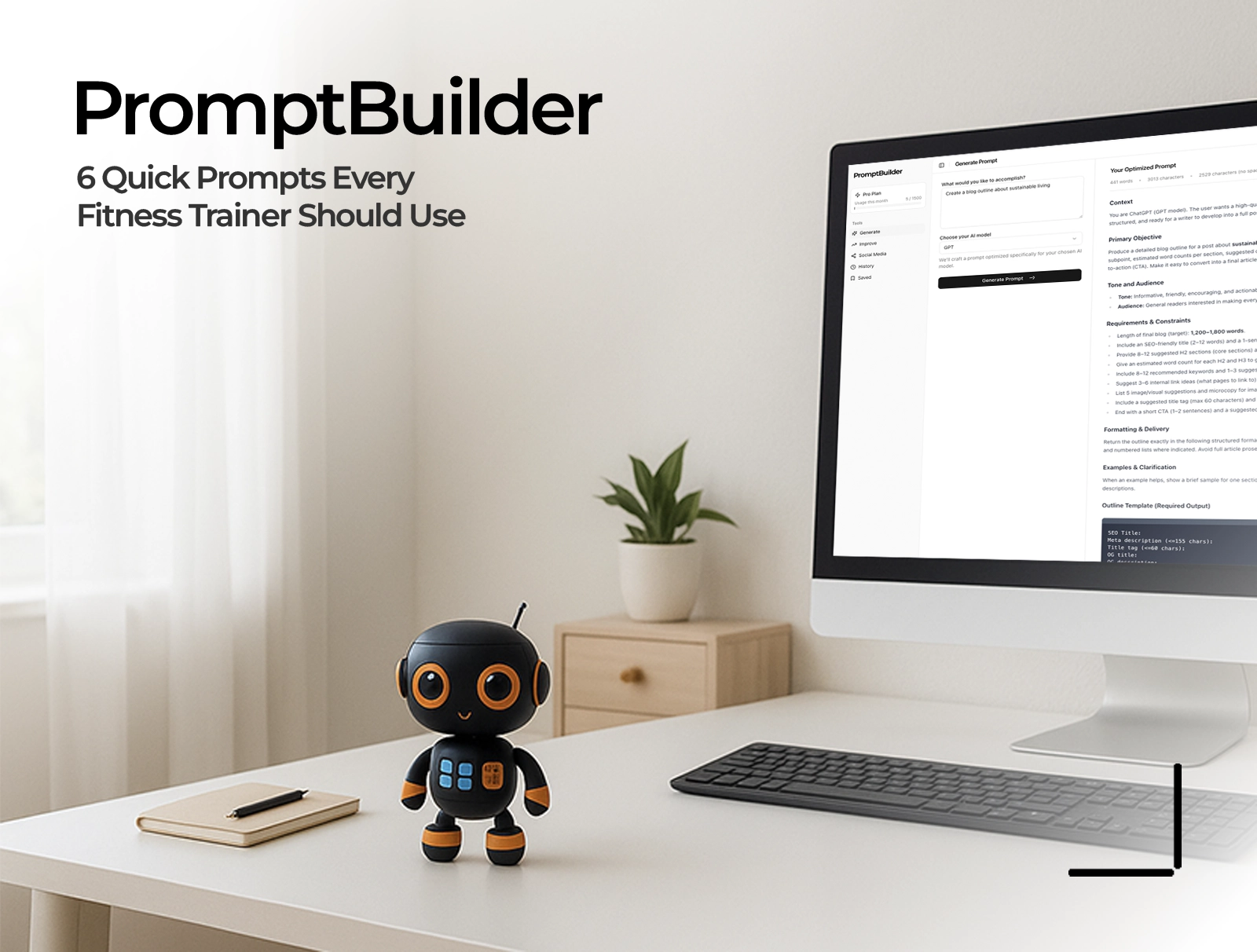How to Use an AI Prompt Generator – Beginner’s Guide to Better Prompts (ChatGPT, Claude, Gemini)
If you’ve ever asked an AI something random and got a vague answer back, you’ve seen why prompts matter. An AI prompt generator turns your rough idea into a clear, structured instruction-so ChatGPT, Claude, and Gemini produce better results on the first try.
This beginner‑friendly guide shows exactly how to use a prompt generator (using PromptBuilder as the example), with before/after comparisons and quick tips you can apply right away.
What is an AI Prompt Generator?
An AI prompt generator is a tool that transforms your goal (plain‑English inputs like “write a LinkedIn post about our launch”) into a high‑quality prompt using proven frameworks and constraints. Instead of guessing what to type, you enter your objective and a few details; the tool assembles a precise, model‑ready prompt.
Why this helps beginners:
- Clear instructions reduce confusion and off‑target answers
- Consistent structure improves reliability across models
- Built‑in templates save time and prevent common mistakes
5 Quick Ways a Prompt Generator Improves Your Prompt
- Adds structure (role, task, context, format)
- Sets constraints (length, tone, style, sources)
- Includes examples when helpful (few‑shot prompts)
- Optimizes for target model (ChatGPT, Claude, Gemini)
- Surfaces guardrails (what to include/avoid)
Step‑by‑Step: Using PromptBuilder’s Prompt Generator
You can follow these steps with any quality prompt generator; the flow below maps to PromptBuilder’s free tool.
1) Choose your target model
- ChatGPT (GPT‑4o): best for structured outputs, code, and creative writing
- Claude 3: best for careful analysis and long‑context reasoning
- Gemini 1.5: best for research synthesis and multimodal inputs
Tip: You can draft once, then adapt the same prompt per model.
2) Enter your goal and audience
Describe what you’re trying to achieve and who it’s for. Be concrete.
- Goal: “Create a LinkedIn post announcing our beta launch”
- Audience: “B2B SaaS founders; professional, concise tone”
3) Add constraints (format, length, must‑haves)
Examples: “150–180 words, include 1 CTA, 3 bullet points, avoid hype words.”
4) Pick tone and output format
Select a tone (e.g., professional, friendly) and a format (bullets, table, JSON, headings). This ensures predictable, copy‑ready results.
5) Generate → Review → Refine
- Generate the prompt
- Review and tweak details (keywords, CTA, examples)
- Copy the final prompt into your model of choice
👉 Try it now: Open the free ChatGPT Prompt Generator at /free-tools/chatgpt-prompt-generator and paste your goal.
Before/After Examples
Example A - ChatGPT (Marketing post)
Bad (vague):
Write a LinkedIn post about our product launch.
Better (generator‑refined):
Role: Senior B2B marketing writer.
Task: Write a LinkedIn post announcing the beta launch of our project management SaaS for SMB teams.
Context: Audience = founders/ops leads; Voice = professional, concise; Value = faster collaboration, reporting; Competitors = Asana/Monday (do not name).
Output: 150–180 words; 1 hook sentence; 3 bullet benefits; 1 CTA to join beta; no jargon.
Quality: Clear value prop; avoid superlatives; keep reading level ~8th grade.
Result: Clear structure, benefits, and CTA-ready to post.
Example B - Claude (Analysis)
Bad (vague):
Should we launch on Product Hunt?
Better (generator‑refined):
Role: Go‑to‑market analyst.
Task: Evaluate whether to launch our beta on Product Hunt this month.
Context: Team of 6; $2k promo budget; early access list 1,200; goal = sign‑ups.
Output: Findings, Assumptions, Risks, Recommendation (<=300 words).
Quality: Cite any assumptions; propose 2 alternatives if confidence < 0.7.
Result: Claude produces a reasoned recommendation with risks and next steps.
Example C - Gemini (Research summary)
Bad (vague):
Summarize SMB AI adoption.
Better (generator‑refined):
Task: Summarize 2024–2025 SMB AI adoption trends.
Parameters: Regions = NA + EU; company size = 10–500; timeframe = last 12 months.
Deliverable: 8–10 bullets with inline citations [1], [2]; table (Source | Claim | Strength | Link); 120‑word executive brief including limitations.
Result: Gemini delivers a scannable, source‑backed brief.
Pro Tips (Power Users)
- Use few‑shot examples: paste 1–2 short samples to lock tone/format
- Add guardrails: “avoid hype words,” “no competitor names,” “no pricing”
- Ask for verification: a short assumptions/edge‑cases section improves reliability
- Save winners: reuse high‑performing prompts as templates
FAQs
Is a prompt generator free to use?
PromptBuilder’s basic generator is free. You can start here: /free-tools/chatgpt-prompt-generator.
Do I need to pick a specific model first?
It helps. The same idea can be formatted differently for ChatGPT, Claude, or Gemini.
Can I collaborate with a team?
Yes-PromptBuilder supports shared libraries and templates on paid plans.
Next Step: Generate Your First Prompt
Ready to see the difference structured prompting makes?
- Try it free: /free-tools/chatgpt-prompt-generator
- Explore more tools: /free-tools/
- Upgrade when you’re ready: /#pricing
Build once, ship across models-faster.


